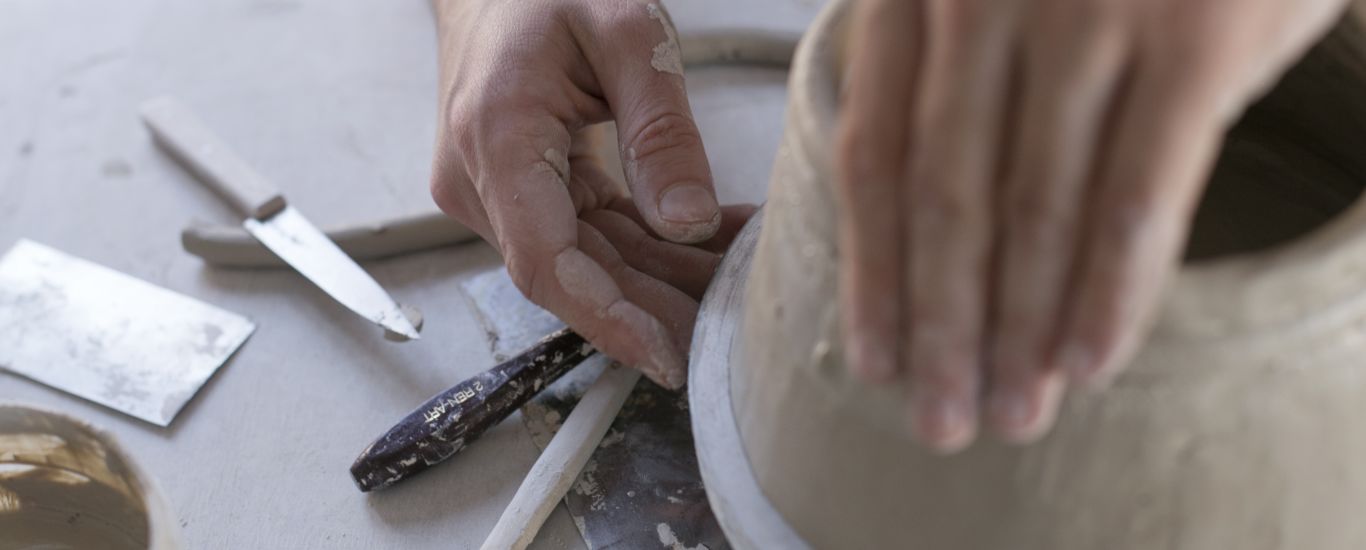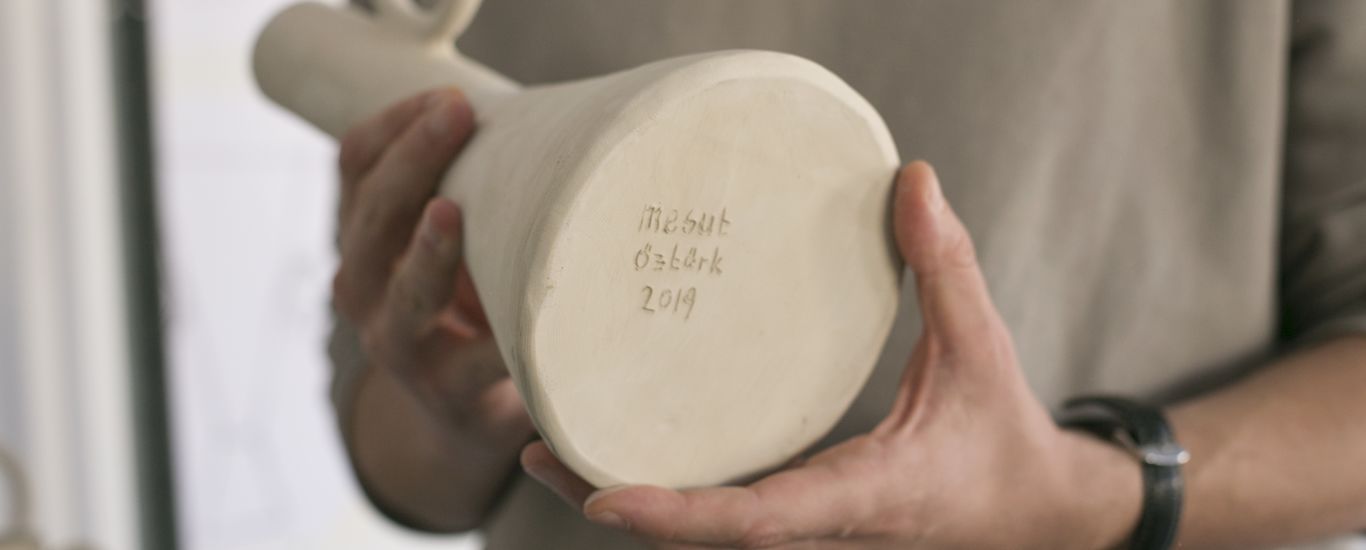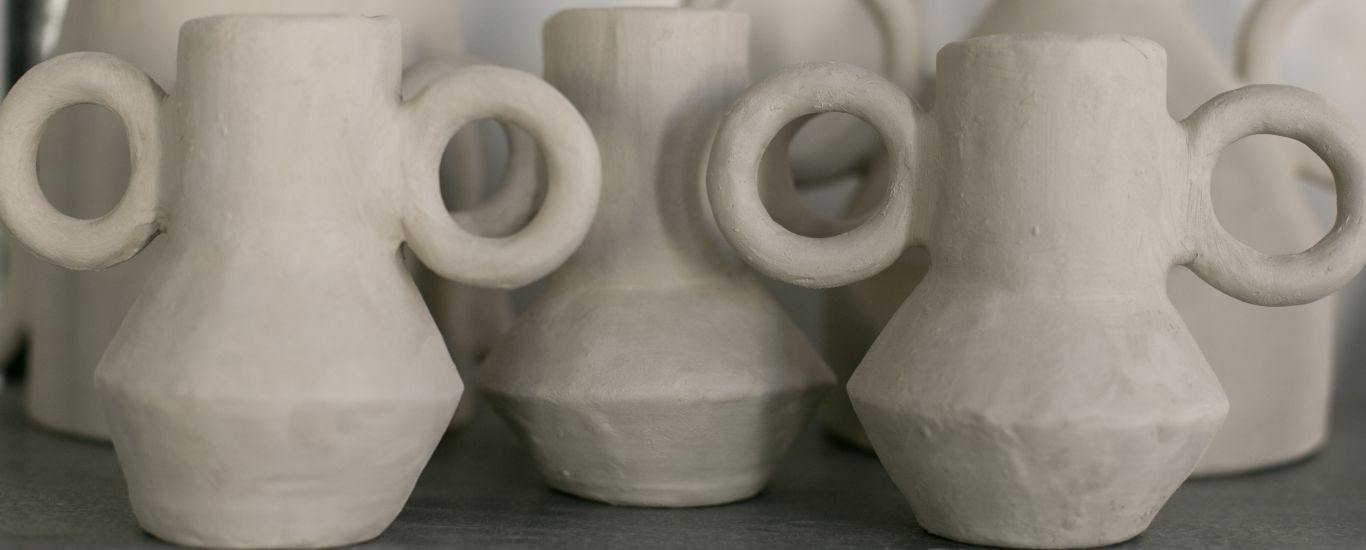Interview and photos by Elif Kahveci
More photos can be accessed here.
We were invited to the workshop-home of Mesut Özturk, architect, part-time lecturer at Bilgi University and newcomer ceramics artist.

How did your education and experience as an architect affect your approach to ceramics?
Architectural education is less like a practical professional training and more like a process that comprehensively develops creativity, at least that’s what I think it should ideally be. The fact that at least half of graduate architects do not practice it as a profession validates this argument. Of course, the creativity here is also related to thinking about education in terms of functionality. For example, when I first started working with ceramics, it scared me to make objects that did not have a function, that were categorically closer to art. In order to develop thought, I needed to find a ‘thing’ that was functional and try to create the best version of it, to expand its limits. While ‘things’ I create resemble a vase more than anything, I think of them as objects that give a sense of functionality but are hard to grasp with regard to their use, and objects that make space for imagination. Besides, I do not start designing/creating to create a vase anyway. I think architectural education gave me the habit of thinking about form and a discipline in design. I can say that I have gone through a design process of thinking through tools of architectural discipline during the time between my introduction to ceramics and creating the Halka (Ring) series. I worked by drawing plans, cross-sections and looks as if the objects I created were buildings; I wanted the mass-façade composition to be consistent and uniform in case these buildings formed a campus.
When did you start working with ceramics? What are the factors that motivate you in creating ceramics?
I started working with ceramics after a couple of events that triggered my thirty-year-old crisis. Since I was a kid, I knew that I was an introverted person who feels happy when they create something individually. When I think back on my most peaceful moments, I see individual moments of creativity like me as a kid drawing alone, transforming the mud in the garden to small statues, designing robots with my Legos, starting a travel blog at university and writing my master’s thesis. Then came adult-like responsibilities such as professional work life, PhD, part-time lecturing work, so I entered a time in which I could not spend enough time on my introverted side and could not set enough connections with any of these responsibilities that I had. I quit my work for my PhD studies, then I was dismissed from my PhD –that I was not very eager to finish anyway– for a weird reason –I got a CB from one of the 9 courses I finished but did not know that the passing grade for a PhD was BB–, and I started thinking about all of this. When I slowed down a bit and questioned what I needed to do, I realised that neither academy nor practice of architecture provides enough possibilities for pure creativity and they were not individual enough, so I started to look for something new. Ceramics, which was on my mind since I visited the retrospective Füreya [Koral] exhibition two years ago, seemed like the ideal answer. The mystery of how it could be made with nearly the same methods since ancient civilizations and that it enables creativity in every age, its relation to architecture through forms of tiles and wall panels, and the fact that it would fulfil the need for creativity that I thought I lost were the primary motivations for me.
How do you assess the difference between arts and crafts? What does ‘hand-made’ mean to you?
Real craft is almost non-existent in today’s world. When we think of ancient church artists or people who built commissioned sculptures in Rome as ‘art’ craftsmen, traditional craft activities that were related to arts evolved into Arts with a capital A in modern times, and remaining crafts melted into mass production.
What I want to do is aspire to the traditional craft model that I romanticised a bit. That’s why I don’t use methods that enable mass production like moulds or 3D prints. I guess I am not the only one that’s bored of everything being mass produced, it makes us unhappy that everything we use lacks a story and soul. Of course, this situation fits the fast and consumption-based lifestyle that we have in today’s world. Creating objects that have a story, that were hand-crafted slowly, is a naïve rebellion against this lifestyle.

What inspires you when you work on your designs?
I really like visiting archaeology museums in cities I travel to. This includes both the big museums of European capitals and the old, lonely archaeology museums in small Anatolian towns. You see various ceramics works of Mediterranean and Mesopotamian civilisations in these museums. I am going to repeat what I said above when I was describing my work: You know that these ceramics were functional, but you can’t instantly decide what their function is; it might be a wine jug or an oil cup. It might have a use specific to that civilisation that we don’t know of today. When you understand the function, then you start elaborating on why the master created that functionality in such form. Did they need four handles? Why is the centre of the jug empty? Does this look like a face? It is apparent that the master is not just designing the tool that will best fulfil the function but is creating forms that they like to create. When you look at it like this, you understand that ceramic earthenware can also be used as an expression, as a tool for expression. My essential muse is earthenware from all these ancient civilisations. I am trying to reinterpret some of the forms that repeat similarly in different civilisations and tying to transform it into a clear design language. I care about this design language being open to variation and enabling new creations.
Your master’s thesis was on the effects of informal political networks on the production methods of squatter settlements, and you picked Güzeltepe – Çayan Neighbourhood as your example. Do you think formations such as Çayan Neighbourhood can be examples of Do-it-Yourself Urbanism?
Squatters are interesting to me in many ways. Firstly, I think the fact that the stock of squatter settlements in the world is larger than formally generated housing is not confronted enough. I can understand West-centric thinking to not care about squatters because the west does not have them, but squatters in Turkey in the context of architecture and urbanism should really be understood. When you look at why and when squatters appeared in the world and how Turkey was included in this process, you get a comprehensive big picture that makes sense sociologically, economically and politically. Secondly, leaving the social aspects aside, squatters are very instructive also in terms of practices of urbanism and architecture. When you see that squatter settlements can provide more habitable physical environments than the areas designed by city planners, and that squatters can respond to the needs of its users better than housing estates designed by architects, the charisma that these architects and planners have go down the drain. Actually, there are parallels between the emergence of squatters in the middle of 20th century and the start of collapse in modernist and positivist paradigms. Squatters are actually primitive and self-emergent examples of participatory planning, a concept that has been debated extensively in recent years. The subject I studied in my thesis also relates to this. I tried to uncover a practice that can be summarised as free distribution of squatters that was planned and collectively built by a leftist group in recent past.
Do you have any ideas on combining architectural practice with ceramics?
I think I have not used all of the potential of the Halka series, so for a while longer it will determine my practice; but at some point, I want to do a series on space-specific installations, wall panels and tiles. I am thinking about contemporary versions of wall panels that were once created extensively in building façades and government institutions.
You are also a lecturer in Faculty of Architecture at Bilgi University. How does lecturing reflect on your own practice?
Yes, I give the 2nd year courses ‘Architectural Design Studio’ and ‘Architectural Drawing’ this term, and I am thinking of running an elective course that intersects ceramics and design next term.
Running the design studio for the last four terms and trying to comment on 12 different projects twice a week trains the mind and hastens it on making design decisions. My lecture habits also encouraged me in organising ceramics workshops. I have ten students right now and we create ceramics in my studio every week.

Can we hear the story of your participation in 1000 VASES in Paris and Simon Porte Jacquemus buying the collection you showcased in the fair?
1000 VASES was one of the hundreds of pages I followed on Instagram that focused on ceramics. I did not even know that there was an exhibition and saw that the account belongs to a fair/exhibition coincidentally, sending an e-mail right away. That evening I got a reply saying I was accepted.
The time was limited, and I had very few vases ready. At the end of a stressful production process, the finished work got out of the oven safe and sound. I filled my checked luggage with cases, put two pieces of clothing in my tote bag and flew to Paris. I have a close friend who lives there, and I was sort of thinking of this exhibition as an excuse to see them. Maybe if it was not for my friend, I wouldn’t even have pursued this. They were telling me for a while that I looked like Jacquemus, there was an ongoing joke between us about that. It was therefore surprising to learn all my work was bought by Jacquemus. After the initial shock of surprise waned, I went to introduce myself and thank him. He said, he came to look for elegant objects for a new restaurant that he was going to open called Oursin, and that he loved my work, so he was not sure whether to display the vases in the restaurant or to keep them to himself. They decided to use them in the restaurant later. They actually asked if I had more, I did not. They broke one; I sold five, now there are four in the restaurant.
Do you have new ceramic works that you started on, works that we can see in the future?
There are actually a lot of ideas that are not ripe yet. I am thinking of a series of tiles where I reinterpret Ottoman and Seljukian geometric patterns; in fact, I have created a few prototypes. It sounds like the patterns of middling hookah cafes when I put it like that, but that’s not what I’m talking about.
I want to produce wall panels created from urban textures of squatters; they are in draft form too.
Although I’ve emphasised individuality a lot above, I am also thinking about various collaborations. For instance, I can collaborate with a texture designer and ask them to put a pattern on one of the works in the Halka series. Collaboration with architectural ceramics companies is also possible.










